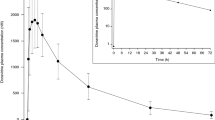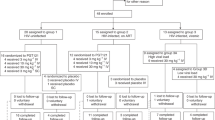Abstract
Purpose
Paclitaxel, a cytotoxic agent metabolized by cytochrome P450 hepatic enzymes, is active for the treatment of human immunodeficiency (HIV) associated Kaposi’s sarcoma. Protease inhibitors are commonly used to treat HIV infection and are known to inhibit cytochrome P450. We sought to determine whether protease inhibitors alter the pharmacokinetics of paclitaxel.
Methods
Patients with advanced HIV-associated KS received paclitaxel (100 mg/m2) by intravenous infusion over 3 h, and plasma samples were collected to measure paclitaxel concentration. The area under the curve (AUC) was calculated using a combination of the log and linear trapezoidal rule, and clearance was calculated as the dose/AUC. Pharmacokinetics were compared with respect to antiretroviral therapy and toxicity,
Results
Thirty-four patients received paclitaxel, of whom 20 had no prior paclitaxel therapy and were assessable for response. Twenty-seven had pharmacokinetic studies performed. Paclitaxel exposure was higher in patients taking protease inhibitors compared to those who were not taking protease inhibitors. The increased exposure did not correlate with efficacy or toxicity. Of the 20 patients assessable for response, 6 (30%) had an objective response and median progression-free survival was 7.8 months (95% confidence interval, 5.6, 21.0 months).
Conclusion
Despite higher exposure to paclitaxel, patients on protease inhibitors did not experience enhanced toxicity or efficacy.
Similar content being viewed by others
References
Biggar RJ, Rosenberg PS, Cote T (1996) Kaposi’s sarcoma, non-Hodgkin’s lymphoma following the diagnosis of AIDS. Multistate AIDS/cancer match study group. Int J Cancer 68:754–758
Moore PS, Chang Y (1995) Detection of herpesvirus-like DNA sequences in Kaposi’s sarcoma in patients with and without HIV infection. N Engl J Med 332:1181–1185
Chang Y, Cesarman E, Pessin MS et al (1994) Identification of herpesvirus-like DNA sequences in AIDS-associated Kaposi’s sarcoma. Science 266:1865–1869
Masood R, Cai J, Zheng T, Smith DL, Naidu Y, Gill PS (1997) Vascular endothelial growth factor/vascular permeability factor is an autocrine growth factor for AIDS-Kaposi sarcoma. Proc Natl Acad Sci USA 94:979–984
Montaner S (2007) Akt/TSC/mTOR activation by the KSHV G protein-coupled receptor: emerging insights into the molecular oncogenesis and treatment of Kaposi’s sarcoma. Cell Cycle 6:438–443
Zeng Y, Zhang X, Huang Z et al (2007) Intracellular Tat of human immunodeficiency virus type 1 activates lytic cycle replication of Kaposi’s sarcoma-associated herpesvirus: role of JAK/STAT signaling. J Virol 81:2401–2417
Aoki Y, Tosato G (2004) HIV-1 Tat enhances Kaposi sarcoma-associated herpesvirus (KSHV) infectivity. Blood 104:810–814
Deregibus MC, Cantaluppi V, Doublier S et al (2002) HIV-1-Tat protein activates phosphatidylinositol 3-kinase/AKT-dependent survival pathways in Kaposi’s sarcoma cells. J Biol Chem 277:25195–25202
Ho DD (1995) Time to hit HIV, early and hard. N Engl J Med 333:450–451
Palella FJ Jr, Delaney KM, Moorman AC et al (1998) Declining morbidity and mortality among patients with advanced human immunodeficiency virus infection. HIV outpatient study investigators. N Engl J Med 338:853–860
Jacobson LP, Yamashita TE, Detels R et al (1999) Impact of potent antiretroviral therapy on the incidence of Kaposi’s sarcoma and non-Hodgkin’s lymphomas among HIV-1-infected individuals. Multicenter AIDS cohort study. J Acquir Immune Defic Syndr 21(Suppl 1):S34–S41
Flexner C (1998) HIV-protease inhibitors. N Engl J Med 338:1281–1292
Mastrolorenzo A, Rusconi S, Scozzafava A, Barbaro G, Supuran CT (2007) Inhibitors of HIV-1 protease: current state of the art 10 years after their introduction. From antiretroviral drugs to antifungal, antibacterial and antitumor agents based on aspartic protease inhibitors. Curr Med Chem 14:2734–2748
Dixit V, Hariparsad N, Li F, Desai P, Thummel KE, Unadkat JD (2007) Cytochrome P450 enzymes and transporters induced by anti-human immunodeficiency virus protease inhibitors in human hepatocytes: implications for predicting clinical drug interactions. Drug Metab Dispos 35:1853–1859
Jackson A, Taylor S, Boffito M (2004) Pharmacokinetics and pharmacodynamics of drug interactions involving HIV-1 protease inhibitors. AIDS Rev 6:208–217
Malaty LI, Kuper JJ (1999) Drug interactions of HIV protease inhibitors. Drug Saf 20:147–169
Tulpule A, Groopman J, Saville MW et al (2002) Multicenter trial of low-dose paclitaxel in patients with advanced AIDS-related Kaposi sarcoma. Cancer 95:147–154
Gill PS, Tulpule A, Espina BM et al (1999) Paclitaxel is safe and effective in the treatment of advanced AIDS-related Kaposi’s sarcoma. J Clin Oncol 17:1876–1883
Welles L, Saville MW, Lietzau J et al (1998) Phase II trial with dose titration of paclitaxel for the therapy of human immunodeficiency virus-associated Kaposi’s sarcoma. J Clin Oncol 16:1112–1121
Saville MW, Lietzau J, Pluda JM et al (1995) Treatment of HIV-associated Kaposi’s sarcoma with paclitaxel. Lancet 346:26–28
Harris JW, Rahman A, Kim BR, Guengerich FP, Collins JM (1994) Metabolism of taxol by human hepatic microsomes and liver slices: participation of cytochrome P450 3A4 and an unknown P450 enzyme. Cancer Res 54:4026–4035
Sparreboom A, van Asperen J, Mayer U et al (1997) Limited oral bioavailability and active epithelial excretion of paclitaxel (Taxol) caused by P-glycoprotein in the intestine. Proc Natl Acad Sci USA 94:2031–2035
Sonnichsen DS, Relling MV (1994) Clinical pharmacokinetics of paclitaxel. Clin Pharmacokinet 27:256–269
Sonnichsen DS, Hurwitz CA, Pratt CB, Shuster JJ, Relling MV (1994) Saturable pharmacokinetics and paclitaxel pharmacodynamics in children with solid tumors. J Clin Oncol 12:532–538
Mielke S, Sparreboom A, Steinberg SM et al (2005) Association of Paclitaxel pharmacokinetics with the development of peripheral neuropathy in patients with advanced cancer. Clin Cancer Res 11:4843–4850
Gianni L, Kearns CM, Giani A et al (1995) Nonlinear pharmacokinetics and metabolism of paclitaxel and its pharmacokinetic/pharmacodynamic relationships in humans. J Clin Oncol 13:180–190
Mielke S, Sparreboom A, Behringer D, Mross K (2005) Paclitaxel pharmacokinetics and response to chemotherapy in patients with advanced cancer treated with a weekly regimen. Anticancer Res 25:4423–4427
Huizing MT, Giaccone G, van Warmerdam LJ et al (1997) Pharmacokinetics of paclitaxel and carboplatin in a dose-escalating and dose-sequencing study in patients with non-small-cell lung cancer. The European cancer centre. J Clin Oncol 15:317–329
Sparreboom A, Verweij J (2003) Paclitaxel pharmacokinetics, threshold models, and dosing strategies. J Clin Oncol 21:2803–2804 author reply 2805-6
Nannan Panday VR, Hoetelmans RM, van Heeswijk RP et al (1999) Paclitaxel in the treatment of human immunodeficiency virus 1-associated Kaposi’s sarcoma–drug-drug interactions with protease inhibitors and a nonnucleoside reverse transcriptase inhibitor: a case report study. Cancer Chemother Pharmacol 43:516–519
Duchin K, Sun J, Tan M, Ilaw M, Cabriales S, Espina BM, East D, Tulpule A, Gill PS 1997 Pharmacokinetics of low-dose Paxene (paclitaxel) in patients with refractory or relapsed AIDS-related Kaposi’s sarcoma. Proc Am Soc Clin. 15 Abstract 235
Cianfrocca M, Cooley TP, Lee JY et al (2002) Matrix metalloproteinase inhibitor COL-3 in the treatment of AIDS-related Kaposi’s sarcoma: a phase I AIDS malignancy consortium study. J Clin Oncol 20:153–159
Sparreboom A, de Bruijn P, Nooter K, Loos WJ, Stoter G, Verweij J (1998) Determination of paclitaxel in human plasma using single solvent extraction prior to isocratic reversed-phase high-performance liquid chromatography with ultraviolet detection. J Chromatogr B Biomed Sci Appl 705:159–164
Krown SE, Metroka C, Wernz JC (1989) Kaposi’s sarcoma in the acquired immune deficiency syndrome: a proposal for uniform evaluation, response, and staging criteria. AIDS clinical trials group oncology committee. J Clin Oncol 7:1201–1207
Pantanowitz L, Schlecht HP, Dezube BJ (2006) The growing problem of non-AIDS-defining malignancies in HIV. Curr Opin Oncol 18:469–478
Martin-Carbonero L, Barrios A, Saballs P et al (2004) Pegylated liposomal doxorubicin plus highly active antiretroviral therapy versus highly active antiretroviral therapy alone in HIV patients with Kaposi’s sarcoma. Aids 18:1737–1740
Fumagalli L, Zucchetti M, Parisi I et al (2000) The pharmacokinetics of liposomal encapsulated daunorubicin are not modified by HAART in patients with HIV-associated Kaposi’s sarcoma. Cancer Chemother Pharmacol 45:495–501
Kappelhoff BS, Huitema AD, Mairuhu AT, Schellens JH, Beijnen JH (2005) No pharmacokinetic drug-drug interaction between nevirapine and paclitaxel. Anticancer Drugs 16:627–630
Ratner L, Lee J, Tang S et al (2001) Chemotherapy for human immunodeficiency virus-associated non-hodgkin’s lymphoma in combination with highly active antiretroviral therapy. J Clin Oncol 19:2171–2178
Acknowledgments
The authors thank Dr. Fayez Hamzeh for performing the pharmacokinetic analysis when he was a faculty member at the Sidney Kimmel Comprehensive Cancer Center at Johns Hopkins (Baltimore, MD), Dr. Michelle Till for her scientific contributions leading to the design of the study and Dr. David Scadden for contributing patients to the study. Supported in part by grants from the Department of Health and Human Services and the National Institutes of Health CA23318 to the Eastern Cooperative Oncology Group (ECOG) statistical center, CA66636 to the ECOG data management center, CA21115 to the ECOG coordinating center and chairman’s office, U01 CA121947 to the AIDS Malignancy Consortium.
Author information
Authors and Affiliations
Corresponding author
Rights and permissions
About this article
Cite this article
Cianfrocca, M., Lee, S., Von Roenn, J. et al. Pilot study evaluating the interaction between paclitaxel and protease inhibitors in patients with human immunodeficiency virus-associated Kaposi’s sarcoma: an Eastern Cooperative Oncology Group (ECOG) and AIDS Malignancy Consortium (AMC) trial. Cancer Chemother Pharmacol 68, 827–833 (2011). https://doi.org/10.1007/s00280-010-1509-4
Received:
Accepted:
Published:
Issue Date:
DOI: https://doi.org/10.1007/s00280-010-1509-4




